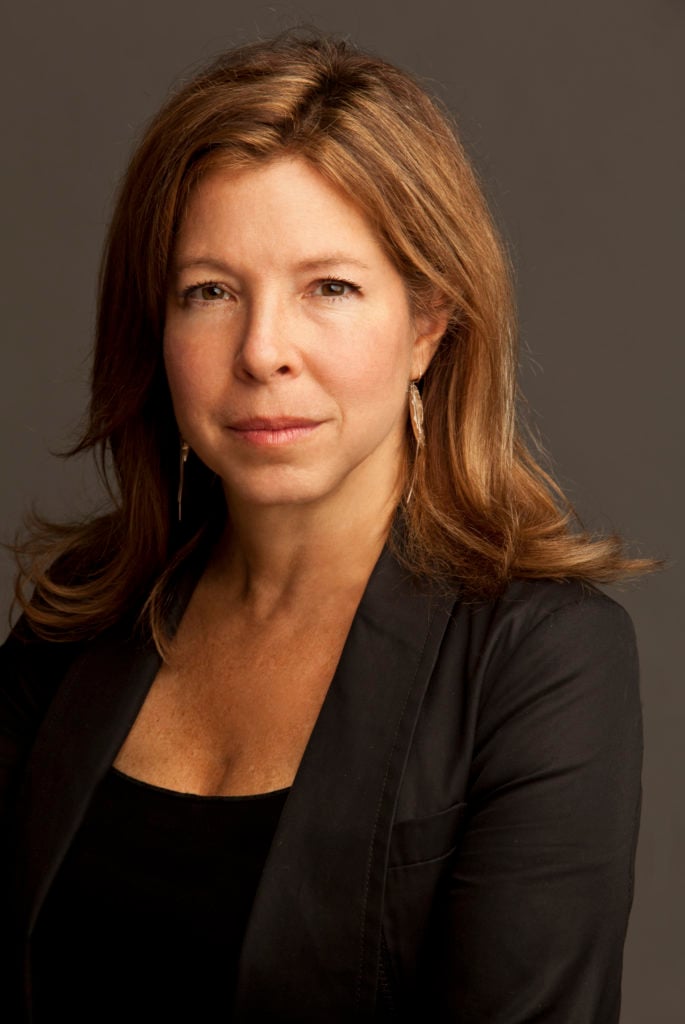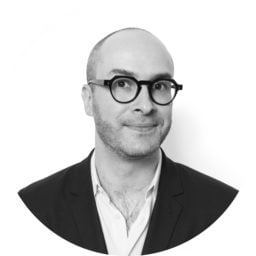Lately, New Yorkers seeking an art experience that meaningfully grapples with the key issues of our polarized times—from battles over identity and representation to the way America can reconcile itself to its unequal past—have been finding themselves walking through the sleek glass doors of the Brooklyn Museum more and more frequently.
The museum kicked off the fall season with two major exhibitions that could not be more relevant to the social tides sweeping both the art world and the culture at large. One of them, “Half the Picture: A Feminist Look at the Collection,” presents artworks that provide an “intersectional feminist framework” with which to refresh one’s perspective of recent art history. The other show, “Soul of a Nation: Art in the Age of Black Power,” celebrates a powerful generation of African American artists—including Emma Amos, Sam Gilliam, and Jack Whitten—who are now enjoying a wellspring of belated recognition. Originally assembled by Tate Modern, “Soul of a Nation” toured to Eastern Parkway at the urging of Darren Walker, the director of international social-justice nonprofit the Ford Foundation, who called up Brooklyn Museum director Anne Pasternak to tip her that an important show was in development. “It was a no-brainer,” Pasternak recalls.
Because the Brooklyn Museum is not within the cynosure of Manhattan, Pasternak’s emergence as a persistent radical within the museum world has not received much notice—aside from occasional flareups from her entrenched adversaries on the left. (The museum’s decision to hire a white curator of African art was one such flashpoint.) But since coming to Brooklyn three years ago after more than two decades at Creative Time, the engaged New York nonprofit behind such public-art sensations as the annual “Tribute In Light” memorial to 9/11 and Kara Walker’s blockbuster sugar sphinx A Subtlety, Pasternak has been gradually remaking the institution as a kind of museological equivalent of Howard Zinn’s A People’s History of the United States, with an eye-opening emphasis on telling the stories behind the dominant narratives.
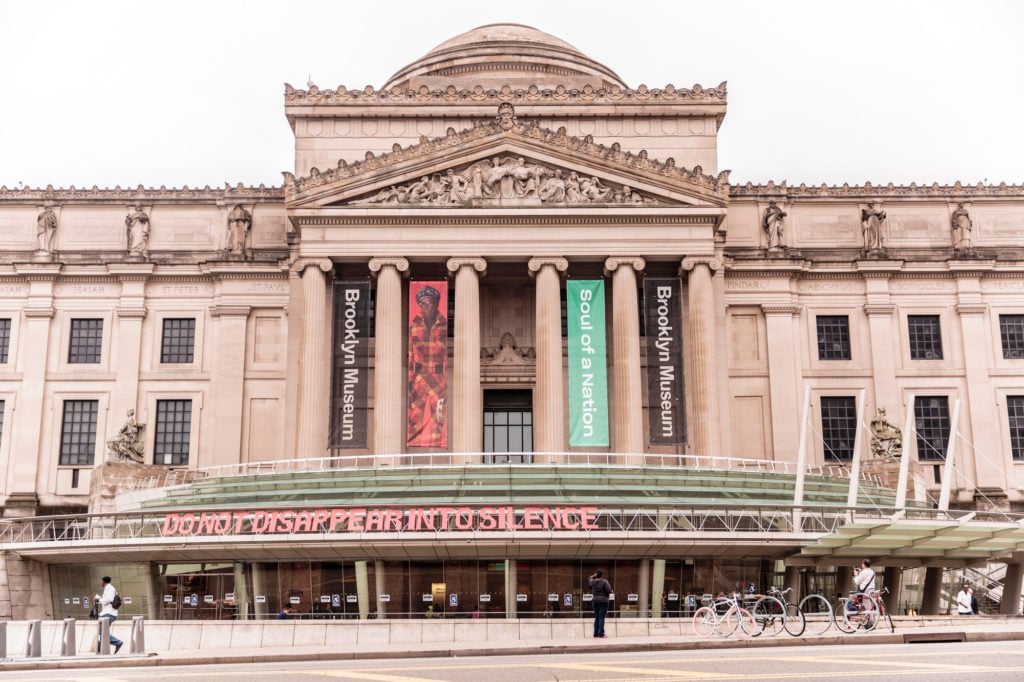
The entrance to the Brooklyn Museum. Photo: Kolin Mendez
The changes in the museum’s perspective can be seen not only through exhibitions but also the collection displays. On a recent walk through the museum, the wall text addresses the viewer from a thought-provoking standpoint where matters of race, gender, and class are all viewed critically, and historical atrocities are brought up immediately. The text for a display titled “America’s First Peoples” begins: “Despite the European conquest and the massacre of millions, the Americas’ indigenous peoples persevered.” Elsewhere, in the American Art section, it notes that “many works were made for and collected by racially and economically privileged segments of society.”
Pasternak has also faced steep administrative obstacles along the way. When she joined the museum, it was an institution facing enduring funding woes and a hole at the bottom the bucket when it came to attendance, with visitor numbers dropping. For 18 years, it had been all held together with verve and old-school finagling by now-retired director Arnold Lehman, who tilted the museum towards populism in hope of growing the audience but was sometimes accused of pandering with fare like a “Star Wars” exhibition.
Today, for a building measuring over half a million square feet and holding some 250,000 objects, the Brooklyn Museum has a lean staff of roughly 350 employees and a bare-bones budget of $38 million. The endowment is just over $100 million, generating roughly $5 million in annual support—just 13 percent of the overall budget, very low by industry standards. As director, Pasternak needs to improve this financial picture.
To find out more about Pasternak’s wide-ranging vision for the Brooklyn Museum and her strategy to build a more sustainable path forward, artnet News’s Andrew Goldstein sat down with the relatively new director in her office overlooking a scale replica of the Statue of Liberty, which stands as a beacon in the institution’s parking lot.

A model of the Statue of Liberty stands in the museum’s rear parking lot. Photo: Andrew Goldstein.
What was the museum like when you entered the job?
Well, on the one hand: what an incredible institution. The history of the museum is so rich—for example, people don’t know it, but Walt Whitman was our early librarians. We have some of the greatest collections in the world, and this beautiful Beaux-Arts building. It also has challenges. Arnold [Lehman, the director of the Brooklyn Museum for 18 years, until 2015] inherited a much more challenging institution, and he left me with a much stronger one. People have no idea. He moved mountains, many visible and some invisible, that were really foundational. That said, every director has work to do to continue a trajectory, and that was certainly the case for me.
What were the most pressing problems to solve when you arrived?
Well, I was walking into a financial crisis, because a bridge fund was running out. But there also needed to be some serious reorganization at the museum, and the financial crisis represented an opportunity to really look at what we were doing and refine it, to rationalize our expenses, to grow our support, and to build an exhibition program that continued to be really unique in a city crowded with other world-class museums. As a result, there were there were many, many levers that we needed to pull, all at once.
You’ve spoken a bit about the museum’s DNA—what did you see as its unique selling proposition when you walked in the door?
If you look historically at what it means to be a great museum, 100 years ago it was measured by your grand temple-like architecture, the number of artworks you had in your collection, and the most famous masterpieces in the collection. Then, in recent decades, it’s been more about expansion—expanding a museum’s footprint along with its budgets. Now, I think the job is really one of reinvention—of questioning the orthodoxies of the past and creating a sustainable, relevant, exciting path forward.
Now, consider that New York City is unique in being the only city in the country—and one of the few in the world—that has two quote-unquote encyclopedic art museums, with the other being the Met. That gives us an opportunity to be more experimental here at the Brooklyn Museum, to be a little more courageous in how we talk about history, and to be more trailblazing in terms of inclusion and diversity, because we don’t have the same burden of expectation that the Met does. We can be more timely, rotate our collections. So when you ask what the Brooklyn Museum offers that is unique, it’s our ability to connect the past to this radical present—and also to engage in broad creativity.
One hundred years ago, when our curator Stewart Culin [the Brooklyn Museum’s first curator of ethnology] was traveling the world collecting, he wasn’t thinking about high/low, he wasn’t thinking about elitism versus populism—he was looking at all these different cultures to find what was excellent in their visual culture. And, by the way, I think that Arnold’s effort was probably also less about populism for its own sake than it was about this embrace of wider creative production. I think museums like ours have lost their way a bit because of destructive paradigms like high/low.
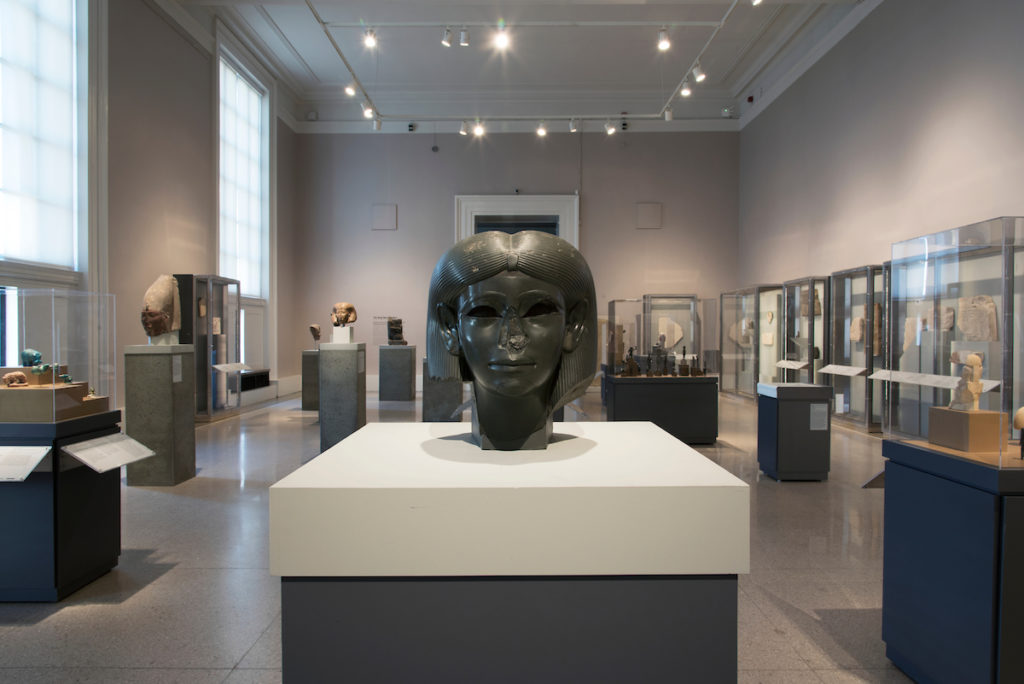
The Brooklyn Museum’s Egyptian Gallery. Photo: Jonathan Dorado
It’s interesting that you bring up the fact that there are two encyclopedic museums in New York, because just because they are encyclopedic doesn’t mean they have to tell the same story—Diderot’s encyclopedia, for instance, has very different emphases than the Encyclopedia Brittanica, or a Chinese encyclopedia. Instead, the aim, as with an encyclopedic museum, is to gather together all of its components to present a cohesive worldview.
Or to question and challenge a cohesive worldview. Providing education and inspiration is important, but I think questioning is equally important for us, and something that is true to our character as a Brooklyn museum. When you think about Brooklyn, you think about moxie, you think about chutzpah. Those are all qualities that the Brooklyn Museum can represent.
A month after your hiring was announced in May 2015, the museum’s 990 filings revealed that it had lost $13 million that previous fiscal year. What was the shape and scale of the financial crisis you inherited? What did you do about it?
That’s actually not correct—990s can be misleading, because of accounting rules for moving funds for capital projects. The museum has not had an operating deficit yet, and I’m quite proud of the fact that over the past three years, despite the very significant challenges we’ve had, we’ve been able to break even or even have a tiny surplus each year. We’re not out of the woods yet, though.
How would you describe the financial picture when you when you arrived, the scope of the challenge, and what needed to be done?
The challenge was really significant. I would say that a significant portion of our budget was facing structural deficits. So, what we’ve been doing is firing all engines. Our board has grown to 39 members; our number of participating foundations has grown by around 40 percent; corporate sponsorships have grown by over 20 percent; and our membership has grown to over 14,000.
So there’s a lot of things that we’ve been doing on the contributed side. On the earned revenue side, we still have a lot of opportunities for growth. Our audience over the last fiscal year, which ended on July 1, was over 650,000 people, and that has a direct impact on our earned revenue.
The challenge, of course, is that we may be the only major art museum in the city that still has pay-what-you-wish admission, and more than 50 percent of our audience doesn’t pay anything. Normally, for museums like ours, ticket sales are a huge part of the operating budget, and we don’t have that.
Plus, people who do pay on average only pay about $9.02—when I got here it was something like $8.34. So we don’t have the normal earned revenue that other institutions have.
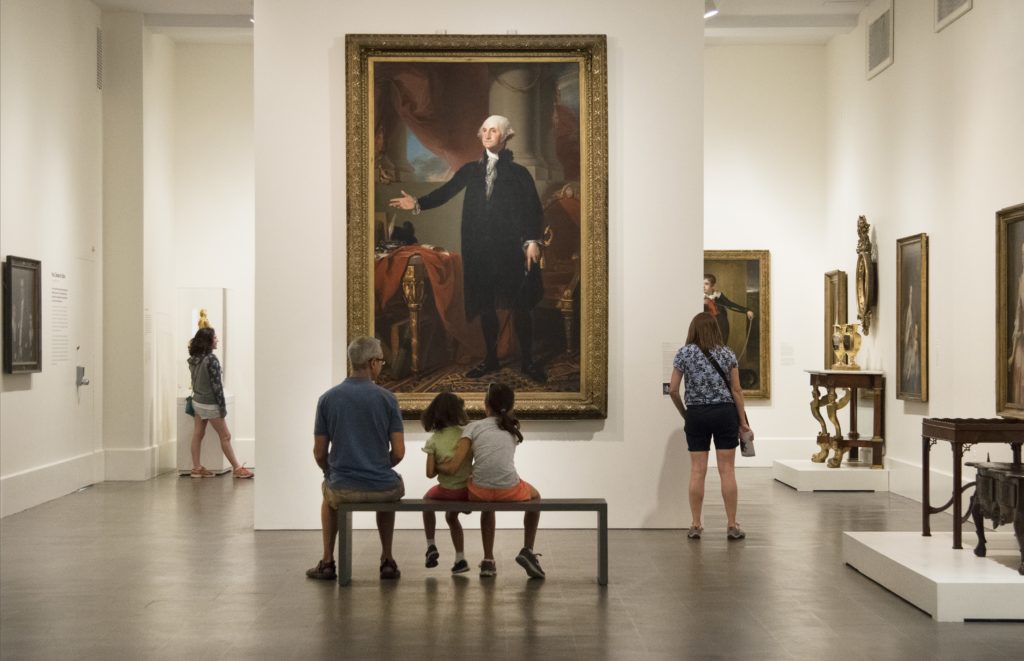
The American Galleries at the Brooklyn Museum. Photo: Sam Prasopthum
There is a public perception that museums are aristocratic, wealthy entities that are awash in patronage and city funding, which is certainly true for a museum like MoMA, but not for every museum.
Well let me go even further with this, because if you look at the Brooklyn Museum, its external appearance is one of great privilege and power, right? But in truth, while we’re one the oldest museums in the country, with one of the greatest and largest collections, we also have one the smallest endowments and the smallest operating budgets and smallest staffs any of encyclopedic museum in the country. So there’s a big gap between the perception and the reality, and that in itself contributes to some real challenges.
You have also lost several key board members recently, isn’t that correct?
In the past year we’ve had three major board members pass away, including Bob Rubin, who was chair of the board for many years and was the angel of this institution. Over the past 20 years, he contributed roughly $100 million to the museum, and that extraordinarily generous funding has now disappeared. One has to wonder if the museum would even exist today if Bob Rubin had not been its great champion for all those years.
Let’s talk about the Brooklyn Museum’s audience. These days, it’s an impressive feat to convince visitors to spend their dwindling leisure hours in a museum when there’s so much competition for everyone’s cultural attention in this new universe of 24/7 streaming entertainment. Why would you say people choose to go to the Brooklyn Museum?
We hear certain things all the time: people feel a sense of welcome here; the people who work here look like them; we are telling the stories and having the conversations that they’re having with friends, with family, and at work; and they see their interests reflected in our exhibitions and the way we position our collections. And they recognize, I think, that it’s not only what stories we’re telling, but who’s telling and shaping those stories.
What would you say is the demographic breakdown of the museum’s audience?
In general, we’re roughly equal between male and female, with slightly more women coming to the museum. The audience is educated, and often has a higher-education degree, either college or graduate-level. It’s also diverse, with more than 50 percent identifying as a person of color. And our audience skews very young, from 20s to mid-40s.
That’s interesting, because in terms of diversity it maps with the future of America at large.
Exactly. And that’s really to Arnold’s credit. He always said the most important book for a museum director to read is the U.S. Census. He really got the importance of diversity, youth, and inclusion before many many others in the field.
One might also see that as making a virtue of necessity, in a certain way, because this museum is in such a polyglot, multicultural melting pot of a borough.
We should look like our community—that’s very important.
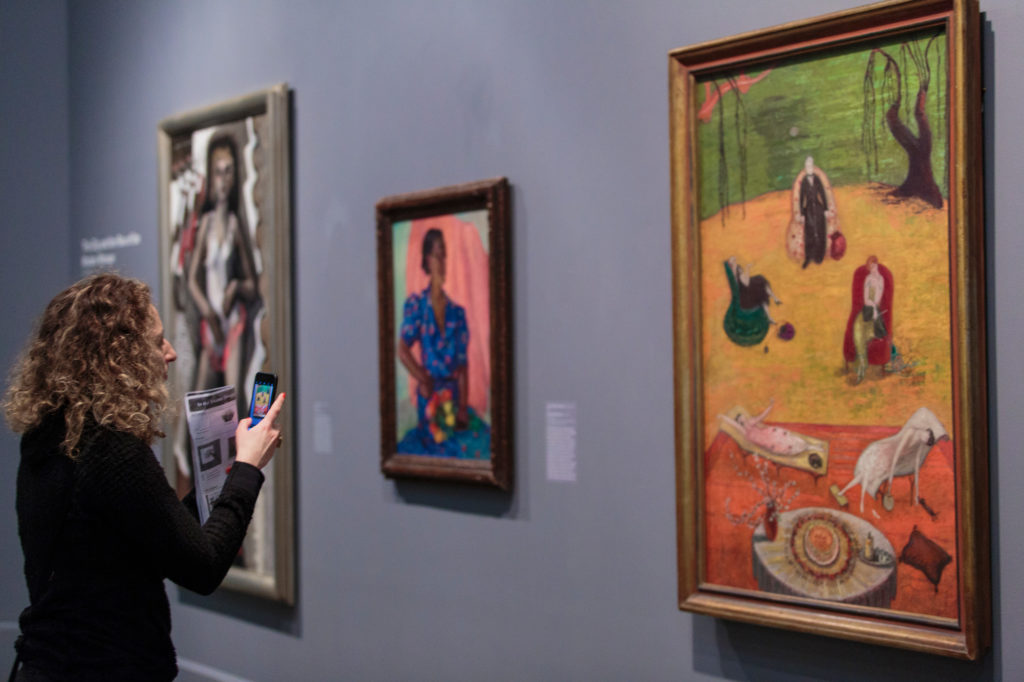
A visitor during Target First Saturdays with adidias: Black History Month at the Brooklyn Museum in February. Photo: Kolin Mendez
What is clear is that you are in the midst of an extraordinary run of shows lately that reframe the conversation, from “We Wanted a Revolution: Black Radical Women, 1965–85” to “The Legacy of Lynching: Confronting Racial Terror in America” to “Radical Women: Latin American Art, 1960–1985” to, currently, “Soul of a Nation: Art in the Age of Black Power” to “Half the Picture: A Feminist Look at the Collection.” At a time when there is a piercing recognition that the voices and visions of women artists and artist of color have been lacking from museums for too long, these shows offer visitors an invigorating opportunity to learn about a part of our cultural history that is only going to become more central over time as the country’s demographics shift. How did you choose these shows, and why?
Well, first of all, this approach is not new for the Brooklyn Museum. Our founders did not create the museum in 1823 to show off their great taste and generosity. They founded the museum because Brooklyn was an independent city full of immigrants, and the idea was that if we looked at each other’s culture and histories, we would be better neighbors, better citizens, and construct a better American project. So, when I came in, it was clear to me that this was part of this institution’s unique selling proposition—that’s why our curators are here, because they can do shows they might not be able to do elsewhere.
That’s also why the feminist direction of our program has been a no-brainer to me. It’s a very clear focus of the museum, galvanized by the Elizabeth Sackler Center for Feminist Art. Sexism is not new, just as racism is not new, and Elizabeth came to the museum with the idea to support women’s art and narratives, and to create greater opportunity for women. As time has gone on, we’ve expanded this feminist lens to a broader human-rights lens. I also wanted to support major exhibitions that didn’t have to just be within the Sackler Center’s galleries, like “We Wanted a Revolution” and “Radical Women.”
We’ve been expanding this broadly feminist lens of equity throughout all the work that we’re doing. And now, 11 years after the Sackler Center first opened, people are really beginning to understand the importance of such an effort to highlight the inequities in our society and the world. In fact, I think it’s high time that other institutions started to follow the Brooklyn Museum’s model.
These issues have really vaulted into the center of the public sphere over the past few years. It’s bracing to think of this timeline: You kicked off a “A Year of Yes: Reimagining Feminism” in October 2016 to celebrate the Sackler Center’s 10-year anniversary. The next month, Trump won. Then the next year saw the rise of the #MeToo movement, creating shockwaves in our society. This September, during Brett Kavanaugh’s contentious Supreme Court hearings, you bravely posted your own #MeToo message on Instagram declaring your experience with sexual assault “numerous times from my teenage years to adulthood” and thanking Christine Blasey Ford for her courage. Later, you said “it is time culture leaders in the US take a stand.” How has the #MeToo movement impacted your vision for the Brooklyn Museum?
My hope with the #MeToo movement that more women, people of color, LGBTQ+—all people—have opportunities to tell stories that create greater dignity, understanding, and empathy. To me, that’s the strength in it: the stories that we’re telling. You know, my Instagram post wasn’t responding directly to Kavanaugh—I was just so concerned about how the discussion was being framed in the media. The #Ibelieveher thing drove me out of my mind, because it just played into a patriarchal view that women are not believable.
Also, people act as if one incident of sexual assault is oh-so-shocking. I’m a big girl, I’m no dummy. I had seven serious sexual assaults, and that’s not even counting my teenage molestation experience. These things are so common, and I felt that, as a cultural leader who knows stories matter, I needed to contribute to the larger discussion. You know, I haven’t spoken about this with anybody, but for me it was really about the need to reframe these paradigms that are so destructive. We get so caught up in these these painful public moments, but for many of us it’s a painful journey, and we’re not having the right conversation. We need to change. We need to flip the script. So that’s that’s why I came out about my experience, and I felt that it mattered.
Part two of this interview addresses the recent controversy over the museum’s hiring of a white African art curator, the Brooklyn Museum’s decision to return funding to Saudi Arabia, and how David Bowie—and loads of data—are helping pave the way for the institution’s future. Read it here.
